Unusual, but beneficial relationships
 Some
of you may have heard the phrase 'no man is an island'. It's true. We
humans are social creatures who constantly interact with other people.
You will be amazed to know that just as much as humans need other
humans, animals too need other animals for survival. Some
of you may have heard the phrase 'no man is an island'. It's true. We
humans are social creatures who constantly interact with other people.
You will be amazed to know that just as much as humans need other
humans, animals too need other animals for survival.
No animal is entirely independent. In fact, in every ecosystem,
animals interact not only with the plants, fungi
|
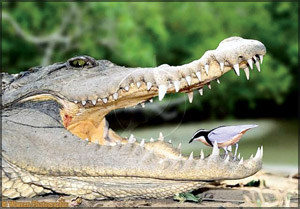
“May I pick your teeth...?” the wader bird readily offers its
services to the Nile crocodile.
|
and other living forms in their surroundings, but also with
other animals.
The interaction between animals take many forms such as casual,
intimate, active, passive, positive and negative. Sometimes the
association between animals is highly complex and even bizarre,
(unusual), leaving many a scientist baffled. Today we will examine one
such form of interaction that is really fascinating which is
scientifically known as symbiosis.
What does symbiosis mean? Literally, it means 'living together'. Well
now you may wonder as to what is so unique about a symbiotic
relationship because, all animals naturally live together in the wilds.
The reason a symbiotic relationship is special is because it is a
mutually beneficial association of different types of organisms. Some of
the symbiotic relationships formed in the animal kingdom which are on
record are indeed extraordinary.
|
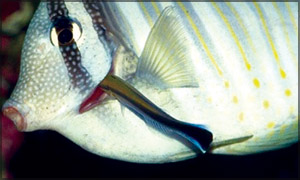
The cleaner wrasse is busy riding the big fish of parasites.
|
Why do animals form symbiotic relationships? What do you think? It is
primarily to rid themselves of unwanted parasites, for protection, or as
bait to lure food. Now let's check out some of these extraordinary
associations.
A common sight in our land, especially in and around paddy fields and
farming areas would be crows or other types of feathered friends
hitching a ride on buffaloes and cattle.
These birds are not merely there for a joy ride. They are there for a
purpose, to rid the big animals of the irksome parasites on their bodies
which they cannot get rid of on their own. Both animals benefit from
this association because the birds fill their tummies and the buffaloes
and cattle stay clean.
Even predatory animals need help to rid themselves of troublesome
parasites. In order to fulfil this purpose, they resist attacking
certain vulnerable animals who are willing to do this service for them,
in exchange for food - the parasites!
One of the most striking examples of a symbiotic relationship is the
association between the Nile crocodile and
|
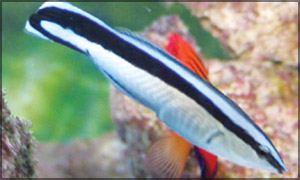
“Be glad I’m not the ‘false one.’
|
the small species of wader birds also aptly (suitably) called
the 'crocodile bird.'
Can you imagine any creature who would dare to even go near a
crocodile, lying with its deadly jaws wide open, leave alone step inside
its mouth? Well, the wader bird does so without any fear of being
'snapped up' by the deadly croc.
The little bird moves freely inside its mouth and body, deftly (skilfully)
extracting leeches and other parasites from its body, and slivers (thin,
small pieces) of meat caught between the crocodile's teeth. The croc
welcomes the services of this little feathered friend because keeping
his teeth in good condition is very important since it's a carnivore.
He cannot use a toothbrush or toothpick, like we do, to get rid of
the food stuck in between his teeth, can he? So, the wader, with its
pointed little beak, acts as a perfect 'toothpick.' Otherwise, the
crocodile most certainly would have made a meal of the bird, the moment
it stepped into its mouth.
|

“Don’t you dare close your mouth until I finish
cleaning your teeth.”
|
Finding another creature to help get rid of irritating parasites or
unwanted attention is a strategy adopted by many in the animals kingdom.
Many such interesting associations are found among the creatures living
in the sea too.
One such 'cleaning' association is that formed between the small and
slender bodied species of stripped fish known as 'cleaner wrasse' and
larger species of fish. Even though at least about 45 species of fish
act as cleaners to larger fish in the sea, the cleaner wrasses are the
most notable, according to marine researchers.
It is said that cleaner wrasse could be easily spotted because it
does a special dance to attract its clients - the larger fish. It swims
vertically with its head pointing downward and sways its body from side
to side.
Larger fish who are in need of cleaning, line up and take turns to be
cleaned by the wrasse. Very large clients,
|
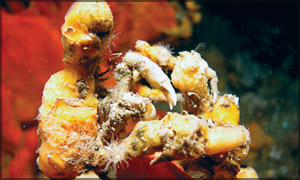
The decorated sponge crab is well masked from its enemies by the
sponge growing all over it.
|
even carnivores permit the wrasse to swim unharmed not only in
their gill chambers, but also inside their mouths. But there is a
dangerous side to this whole clean up operation by the wrasses; the
possibility of coming under attack by a 'false cleaner.' A sinister
duplicate of the wrasse has evolved, featuring a deceitful species of
blenny, appropriately called 'the false cleaner.'
This creature is like the wrasse in every sense, but instead of
cleaning, it makes a meal of the big client. After luring its client,
the false cleaner swiftly bites a chunk out of the unfortunate client's
fins.
Another marine species famous for forming symbiotic relationships are
crabs. We know that crabs usually have coverings such as shells to
protect their soft bodies from prey.
Hermit crabs are famous for seeking out empty shells to protect their
soft bodies. They also attract sea anemones to their shells because they
act as stinging shields against predators.
However, some deep-sea hermit crabs do not waste time looking for
such protective gear. They keep their soft
|
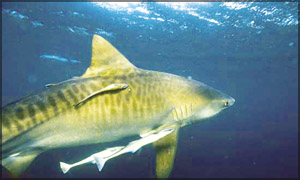
A shark being groomed by remoras.
|
bodies hidden among sea anemones which give them protection from
outside assailants.
Would you believe that some species of crabs even carry these sea
anemones in their claws, like weapons? The moment they feel threatened,
they thrust the sea anemones at the would be aggressors like fiery
torches.
The anemones gain food and nutrients from this relationship. The
sponge crab too uses an unusual method of survival with the help of a
symbiotic relationship. What the crab does is use the sponge as
camouflage. In fact, it places a sponge on top of its body and allows it
to gradually grow all over it.
And what does the sponge gain from it? A free ride of course! But
it's not just another ride in the waters. By being carried by the crab,
the flow of water through the sponge increases. This enables the sponge
to not only absorb more nutrients, but also get a regular and varied
diet.
The symbiotic relationship between a honey guide, a small relative of
the woodpecker, and a large, fierce badger-like mammal known as the
ratel or honey badger is also truly amazing.
The honeyguide is adept at locating beehives, but it prefers not to
break into them to obtain the wax. So, what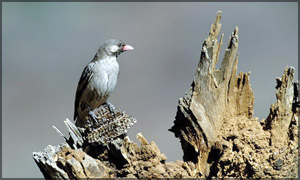 do you think it does? Seek assistance from the powerful honey-loving
ratel. The honey guide attracts the attention of any ratel which happens
to be in the location by letting out a special cry the moment it spots a
beehive.
do you think it does? Seek assistance from the powerful honey-loving
ratel. The honey guide attracts the attention of any ratel which happens
to be in the location by letting out a special cry the moment it spots a
beehive.
The ratel follows the direction of the honey bird's cry as it hops
from tree to tree, leading its partner to the hive. The formidable ratel
spares no time in tearing open a hive once it spots the hive. The honey
guide patiently waits till the ratel has its fill and the bees calm
down, and then it happily eats whatever wax is left in the beehive.
Apart from crabs, there are other creatures in the sea that form
symbiotic relationships.
Most of you would have watched the famous movie "Finding Nemo". Well,
then, you'll remember that Nemo is a baby clown fish and that it usually
lives among sea anemones.
Clown fish are well protected among sea anemones who gain from their
presence by the prey the fish lure.
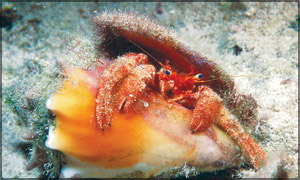 Is
any one of you familiar with the Portuguese man-of-war? If not, let us
enlighten you....It's definitely not a Portuguese soldier, but a deadly
creature that lives in the sea. Its long, vertical curtain of tentacles
that trails down through the water as it travels is deadly to most
animals. Is
any one of you familiar with the Portuguese man-of-war? If not, let us
enlighten you....It's definitely not a Portuguese soldier, but a deadly
creature that lives in the sea. Its long, vertical curtain of tentacles
that trails down through the water as it travels is deadly to most
animals.
However, a small species of blue and white fish known as horse
mackerel manages to spend a lot of its time swimming among the
Portuguese man-of-war's tentacles because it can withstand the potent
stinging cells of the tentacles. The horse mackerels are well protected
from bigger fish that come to attack them because they get stung by the
tentacles. And then, the Portuguese man-of-war makes a meal of them.
Similar symbiotic relationships are formed between voracious sharks
and small remoras. The remora is not only protected by the shark, it
also gets food; the chunks of meat that fall from the carcass of a
shark's victim are eaten by the remora. And in return, the remora helps to groom the shark.
eaten by the remora. And in return, the remora helps to groom the shark.
It swims all over the shark's body and eats any parasites attached to
the body and also any dead tissue it finds on the shark's body. Some
species of remora attach themselves to different big fish and even
turtles sometimes.
Don't you think the lifestyles and the various methods animals adopt
to survive are fascinating? Find out more about other symbiotic
relationships in the animal kingdom. |
